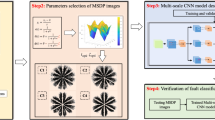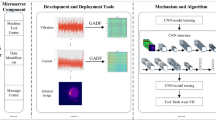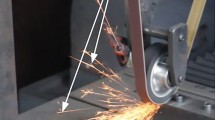Abstract
In the abrasive belt grinding process, actual material removal is an important parameter that affects its accuracy. At present, for obtaining the actual material removal, offline measurements are required to establish the mathematical prediction model. To improve the accuracy and efficiency of abrasive belt machine grinding, this paper proposes a novel method for monitoring material removal using multiple sensors and a two-dimensional (2D) convolutional neural network (2D-CNN) learning algorithm. In this method, features of multiple types (color, texture, and shape) are extracted from vision signals, and that of multiple domains (time, frequency, and time–frequency domain) are extracted from sound and tactile signals. These features are constructed into a 2D feature matrix as the input model, and the 2D-CNN prediction model is established between the multisensor features and the material removal rate of the abrasive belt grinding process. An experimental dataset is used to train and verify the established model. The results show that the proposed method can identify that sensor signals are sensitive to the material removal rate. After optimizing and tuning the model parameters, the coefficient of determination of the prediction results is as high as 94.5% and the root mean square error is 0.017. Therefore, the proposed method can be employed for the prediction of material removal rate for different belt specifications and different grinding parameters. Compared to traditional machine learning methods, this method can yield better training results without feature selection and optimization.











Similar content being viewed by others
Availability of data and materials
The datasets used or analyzed during the current study are available from the corresponding author on reasonable request.
References
Jourani A, Dursapt M, Hamdi H, Rech J, Zahouani H (2005) Effect of the belt grinding on the surface texture: Modeling of the contact and abrasive wear. Wear 259(7–12):1137–1143
Lv YJ, Peng Z, Qu C, Zhu DH (2020) An adaptive trajectory planning algorithm for robotic belt grinding of blade leading and trailing edges based on material removal profile model. Robot. Comput.-Integr. Manuf. 6:101978.
Xiao GX, Huang Y (2017) Experimental research and modeling of life-cycle material removal in belt finishing for titanium alloy. J Manuf Process 30:255–267
Tian YB, Liu F, Wang Y, Wu H (2017) Development of portable power monitoring system and grinding analytical tool. J Manuf Process 27:188–197
Tian YB, Li LG, Fan S, Guo QJ, Cheng X (2020) A novel high-shear and low-pressure grinding method using specially developed abrasive tools. P I Mech Eng B-J Eng 235(1–2):095440542094910
Pandiyan V, Tjahjowidodo T, Samy MP (2016) In-process surface roughness estimation model for compliant abrasive belt machining process. Procedia Cirp 46:254–257
Khellouki A, Rech J, Zahouani H (2007) The effect of abrasive grain’s wear and contact conditions on surface texture in belt finishing. Wear 263(1–6):81–87
Fan WG, Wang WX, Wang JD, Zhang XL, Qian C, Ma TF (2021) Microscopic contact pressure and material removal modeling in rail grinding using abrasive belt. P I Mech Eng B-J Eng 235(1–2):3–12
Jamshidi H, Budak E (2020) An analytical grinding force model based on individual grit interaction. J. Mater. Process. Tech. 283:116700.
Jamshidi H, Budak E (2021) On the prediction of surface burn and its thickness in grinding processes. CIRP Ann.–Manuf. Technol 70:285–288
Jin XL, Zhang LC (2012) A statistical model for material removal prediction in polishing. Wear 274–275:203–211
Pandiyan V, Caesarendra W, Tjahjowidodo T, Praveen G (2017) Predictive modelling and analysis of process parameters on material removal characteristics in abrasive belt grinding process. Appl Sci 7(363):2–17
Ren LJ, Zhang GP, Wang Y, Zhang Q, Wang F, Huang Y (2019) A new in-process material removal rate monitoring approach in abrasive belt grinding. Int J Adv Manuf Technol 104(2):2715–2726
Ren LJ, Zhang GP, Wang QW (2019) Image-based prediction model for material removal rate of abrasive belt grinding. J Sci Instrum 40(12):127–134
Kurada S, Bradley C (1997) A review of machine vision sensors for tool condition monitoring. Comput Ind 34(1):55–72
Zhou YQ, Sun BT, Sun WF, Lei L (2020) Tool wear condition monitoring based on a two-layer angle kernel extreme learning machine using sound sensor for milling process. J. In-tell. Manuf. 5–8.
Milfelner M, Cus F, Balic J (2005) An overview of data acquisition system for cutting force measuring and optimization in milling. J Mater Process Tech 164–165:1281–1288
Chen B, Chen X, Li B, He Z, Cao H, Cai G (2011) Reliability estimation for cutting tools based on logistic regression model using vibration signals. Mech Syst Signal Process 25:2526–2537
Zhou J, Pang CK, Zhong Z, Lewis FL (2011) Tool wear monitoring using acoustic emissions by dominant-feature identification. IEEE Trans Instrum Meas 60:547–559
Freyer BH, Heyns PS, Theron NJ (2014) Comparing orthogonal force and uni-directional strain component processing for tool condition monitoring. J In-tell Manuf 25:473–487
Sarhan AAD, Matsubara A (2015) Investigation about the characterization of ma-chine tool spindle stiffness for intelligent CNC end milling. Robot Comput-Integr Manuf 34:133–139
Salgado DR, Alonso FJ (2007) An approach based on current and sound signals for in-process tool wear monitoring. Int J Mach Tools Manuf 47:2140–2152
Wang NN, Zhang GP, Pang WJ, Ren LJ, Wang YP (2021) Novel monitoring method for material removal rate considering quantitative wear of abrasive belts based on LightGBM learning algorithm. Int J Adv Manuf Technol 114:13241–13253
Duwell EJ, Hong IS, Mcdonald WJ (1969) The effect of oxygen and water on the dynamics of chip formation during grinding. ASLE Trans 12(1):86–93
Wang NN, Zhang GP, Ren LJ, Pang WJ, Wang YP (2021) Vision and sound fusion-based material removal rate monitoring for abrasive belt grinding using improved LightGBM algorithm. J Manuf Process 66:281–292
Lin H, Sun S (2019) An overview of multirate multisensor systems: modelling and estimation. Inform Fusion 52:335–343
Zhang XQ, Chen HB, Xu JJ, Song XF, Wang JW, Chen XQ (2018) A novel sound-based belt condition monitoring method for robotic grinding using optimally pruned extreme learning machine. J Mater Process Tech 260:9–19
Pandiyan V, Caesarendra W, Tjahjowidodo T, Tan HH (2018) In-process tool condition monitoring in compliant abrasive belt grinding process using support vector machine and genetic algorithm. J Manuf Process 31:199–213
Cheng C, Li JY, Liu YM, Nie M, Wang WX (2020) An online belt wear monitoring method for abrasive belt grinding under varying grinding parameters. J Manuf Process 50:80–89
Gao KY, Chen HB, Zhang XQ, Ren XK, Chen JQ, Chen XQ (2019) A novel material removal prediction method based on acoustic sensing and ensemble XGBoost learning algorithm for robotic belt grinding of Inconel 718. Int J Adv Manuf Technol 105:217–232
Hinton GE, Salakhutdinov RR (2006) Reducing the dimensionality of data with neural networks. Science 313:504–507
Krizhevsky A, Sutskever I, Hinton GE (2012) ImageNet classification with deep convolutional neural networks. In 21th annual conference on neural information processing systems (NIPS). Lake Tahoe, USA, December 3–8.
Cheng C, Li JY, Liu YM, Nie M, Wang WX (2019) Deep convolutional neural network-based in-process tool condition monitoring in abrasive belt grinding. Comput Ind 106:1–13
Qi JD, Chen B, Zhang D (2020) Multi-information fusion-based belt condition monitoring in grinding process using the improved-Mahalanobis distance and convolutional neural networks. J Manuf Process 59:302–315
Huang Z, Zhu J, Lei J, Li X, Tian F (2020) Tool wear predicting based on multi-domain feature fusion by deep convolutional neural network in milling operations. J In-tell Manuf 31:953–966
Rifai AP, Aoyama H, Tho NH, Dawal SZM, Masruroh NA (2020) Masruroh Evaluation of turned and milled surfaces roughness using convolutional neural network. Measurement 161:107860.
Gu KK, Lin Q, Wang WJ, Wang HY, Guo J, Liu QY et al (2015) Analysis on the effects of rotational speed of grinding stone on removal behavior of rail material. Wear 342–343:52–59
Zhou K, Ding HH, Wang WJ, Wang RX, Guo J, Liu QY (2019) Influence of grinding pressure on removal behaviours of rail material. Tribol Int 134:417–426
Funding
This work was supported by the Shaanxi Province key projects (grant number 2017ZDXM-GY-133).
Author information
Authors and Affiliations
Contributions
Nina Wang performed the analysis and summary of the experimental data, and was a major contributor in writing the manuscript. Lijuan Ren, Yongchang Li and Zhijian Yang participate in carrying out grinding experiments. All authors read and approved the final manuscript.
Corresponding author
Ethics declarations
Ethical approval
All data in this paper comes from machining grinding experiments and does not involve ethical issues.
Consent to participate
Not applicable.
Consent to publish
Not applicable.
Conflict of interest
The authors declare no competing interests.
Additional information
Publisher's Note
Springer Nature remains neutral with regard to jurisdictional claims in published maps and institutional affiliations.
Rights and permissions
About this article
Cite this article
Wang, N., Zhang, G., Ren, L. et al. In-process material removal rate monitoring for abrasive belt grinding using multisensor fusion and 2D CNN algorithm. Int J Adv Manuf Technol 120, 599–613 (2022). https://doi.org/10.1007/s00170-022-08768-2
Received:
Accepted:
Published:
Issue Date:
DOI: https://doi.org/10.1007/s00170-022-08768-2




